Siemens Case Study: Building an Ethical Organizational Culture
VerifiedAdded on 2023/05/28
|8
|1507
|141
Case Study
AI Summary
This case study examines Siemens' ethical organizational culture, focusing on the elements of a zero-tolerance ethics policy and evaluating the company's efforts to root out corruption. It assesses the impact of unethical behavior on Siemens' image and credibility, highlighting past bribery scandals. The study proposes steps for Siemens to adopt ethical practices, including a comprehensive code of conduct, ethical training, and confidential reporting channels. It emphasizes the importance of creating a decent organizational culture through fair treatment of employees and consistent enforcement of ethical policies. The analysis concludes by suggesting strategies such as improved communication and disciplinary measures to foster a healthy ethical climate, enabling Siemens to regain trust and respect in the market. This document is available on Desklib, a platform offering a wide range of study resources for students.
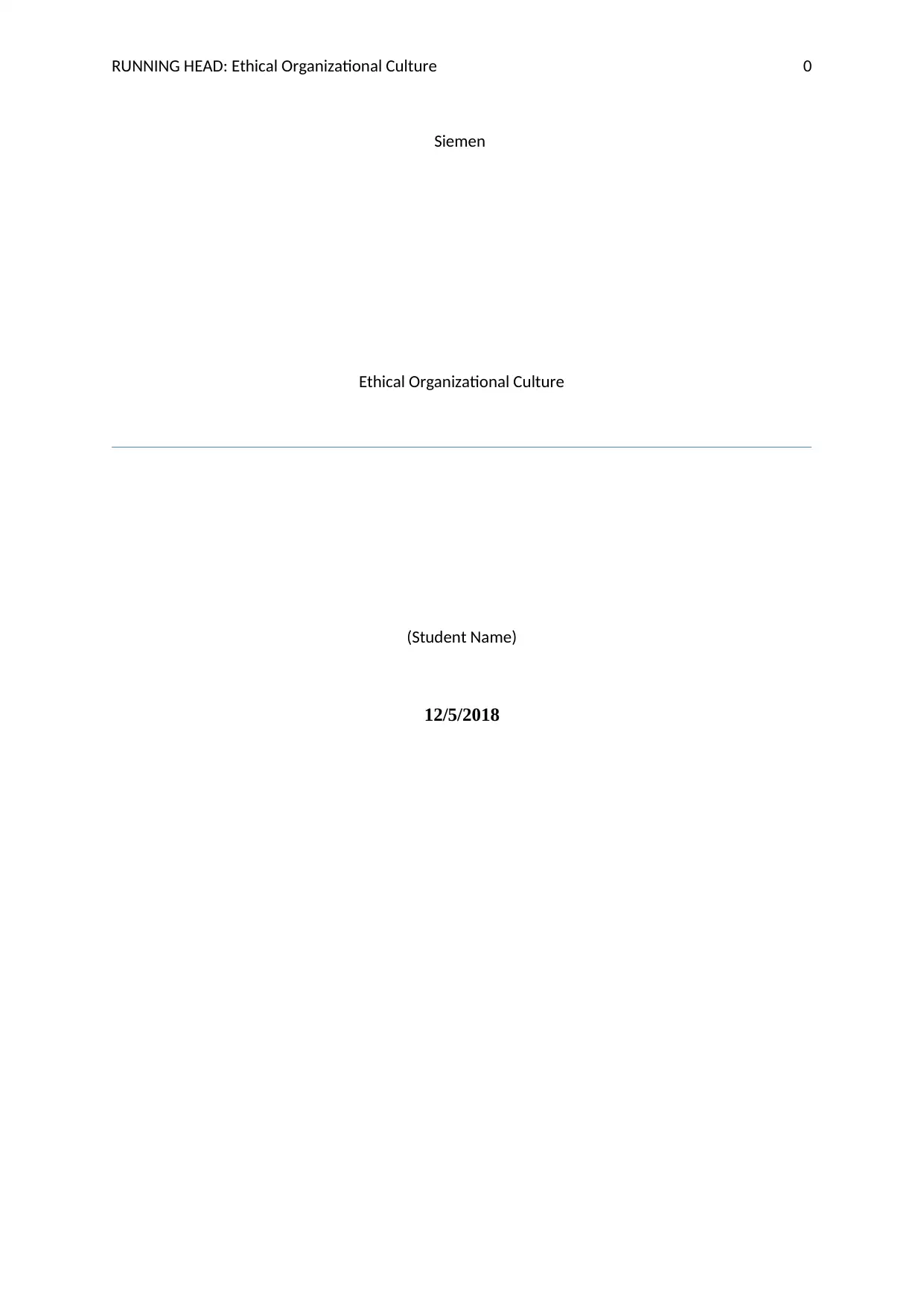
RUNNING HEAD: Ethical Organizational Culture 0
Siemen
Ethical Organizational Culture
(Student Name)
12/5/2018
Siemen
Ethical Organizational Culture
(Student Name)
12/5/2018
Paraphrase This Document
Need a fresh take? Get an instant paraphrase of this document with our AI Paraphraser
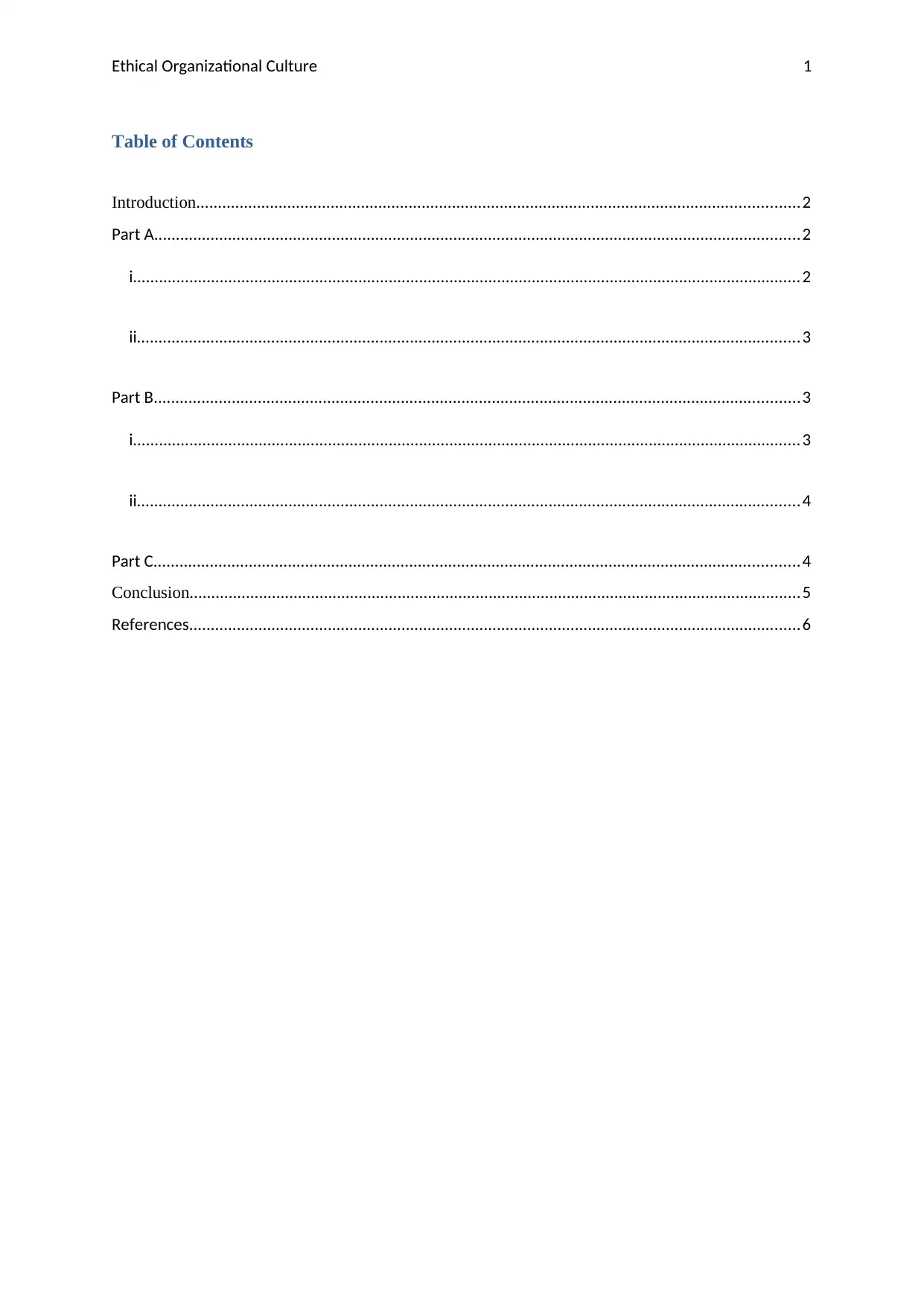
Ethical Organizational Culture 1
Table of Contents
Introduction...........................................................................................................................................2
Part A.....................................................................................................................................................2
i..........................................................................................................................................................2
ii.........................................................................................................................................................3
Part B.....................................................................................................................................................3
i..........................................................................................................................................................3
ii.........................................................................................................................................................4
Part C.....................................................................................................................................................4
Conclusion.............................................................................................................................................5
References.............................................................................................................................................6
Table of Contents
Introduction...........................................................................................................................................2
Part A.....................................................................................................................................................2
i..........................................................................................................................................................2
ii.........................................................................................................................................................3
Part B.....................................................................................................................................................3
i..........................................................................................................................................................3
ii.........................................................................................................................................................4
Part C.....................................................................................................................................................4
Conclusion.............................................................................................................................................5
References.............................................................................................................................................6
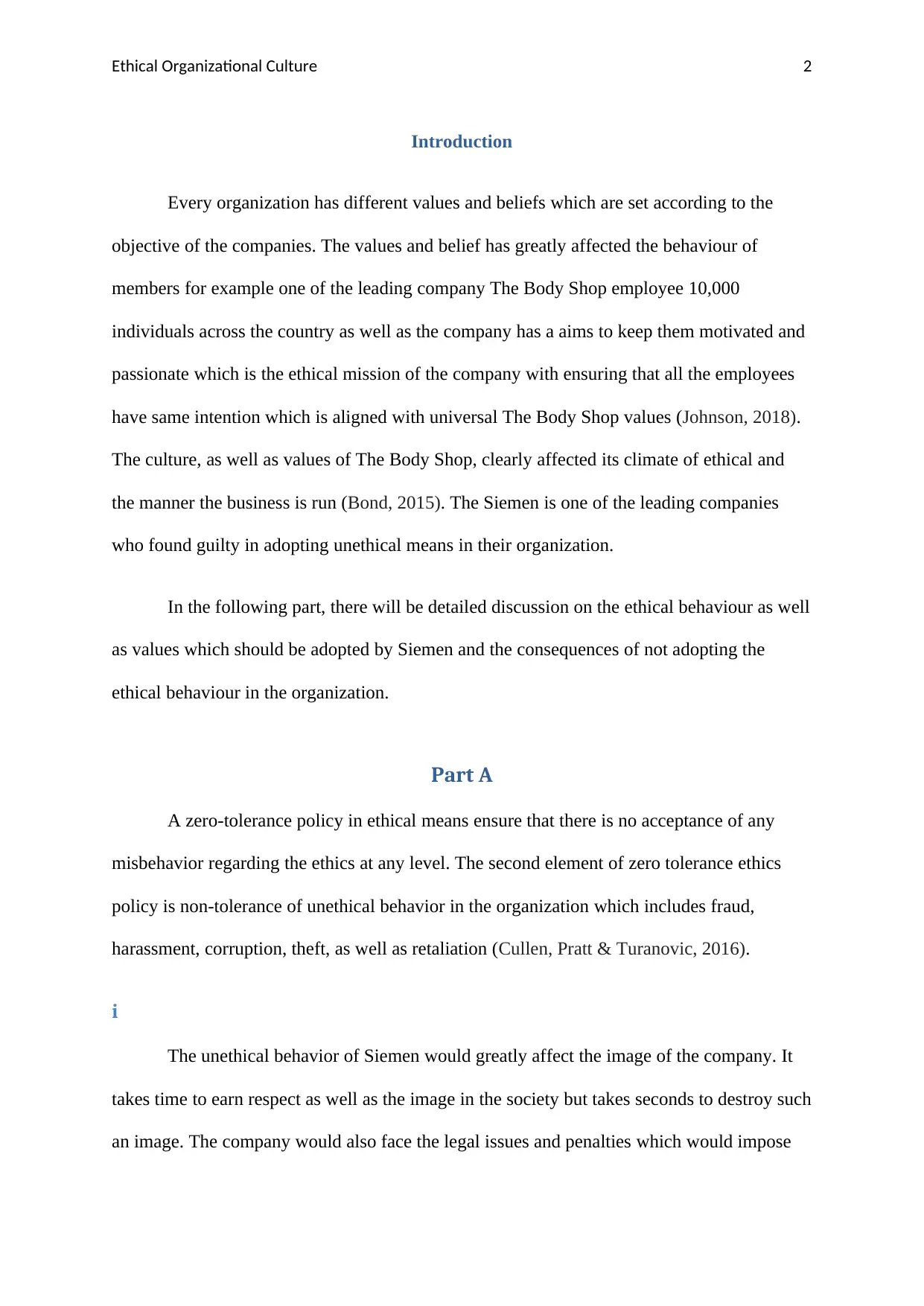
Ethical Organizational Culture 2
Introduction
Every organization has different values and beliefs which are set according to the
objective of the companies. The values and belief has greatly affected the behaviour of
members for example one of the leading company The Body Shop employee 10,000
individuals across the country as well as the company has a aims to keep them motivated and
passionate which is the ethical mission of the company with ensuring that all the employees
have same intention which is aligned with universal The Body Shop values (Johnson, 2018).
The culture, as well as values of The Body Shop, clearly affected its climate of ethical and
the manner the business is run (Bond, 2015). The Siemen is one of the leading companies
who found guilty in adopting unethical means in their organization.
In the following part, there will be detailed discussion on the ethical behaviour as well
as values which should be adopted by Siemen and the consequences of not adopting the
ethical behaviour in the organization.
Part A
A zero-tolerance policy in ethical means ensure that there is no acceptance of any
misbehavior regarding the ethics at any level. The second element of zero tolerance ethics
policy is non-tolerance of unethical behavior in the organization which includes fraud,
harassment, corruption, theft, as well as retaliation (Cullen, Pratt & Turanovic, 2016).
i
The unethical behavior of Siemen would greatly affect the image of the company. It
takes time to earn respect as well as the image in the society but takes seconds to destroy such
an image. The company would also face the legal issues and penalties which would impose
Introduction
Every organization has different values and beliefs which are set according to the
objective of the companies. The values and belief has greatly affected the behaviour of
members for example one of the leading company The Body Shop employee 10,000
individuals across the country as well as the company has a aims to keep them motivated and
passionate which is the ethical mission of the company with ensuring that all the employees
have same intention which is aligned with universal The Body Shop values (Johnson, 2018).
The culture, as well as values of The Body Shop, clearly affected its climate of ethical and
the manner the business is run (Bond, 2015). The Siemen is one of the leading companies
who found guilty in adopting unethical means in their organization.
In the following part, there will be detailed discussion on the ethical behaviour as well
as values which should be adopted by Siemen and the consequences of not adopting the
ethical behaviour in the organization.
Part A
A zero-tolerance policy in ethical means ensure that there is no acceptance of any
misbehavior regarding the ethics at any level. The second element of zero tolerance ethics
policy is non-tolerance of unethical behavior in the organization which includes fraud,
harassment, corruption, theft, as well as retaliation (Cullen, Pratt & Turanovic, 2016).
i
The unethical behavior of Siemen would greatly affect the image of the company. It
takes time to earn respect as well as the image in the society but takes seconds to destroy such
an image. The company would also face the legal issues and penalties which would impose
⊘ This is a preview!⊘
Do you want full access?
Subscribe today to unlock all pages.

Trusted by 1+ million students worldwide
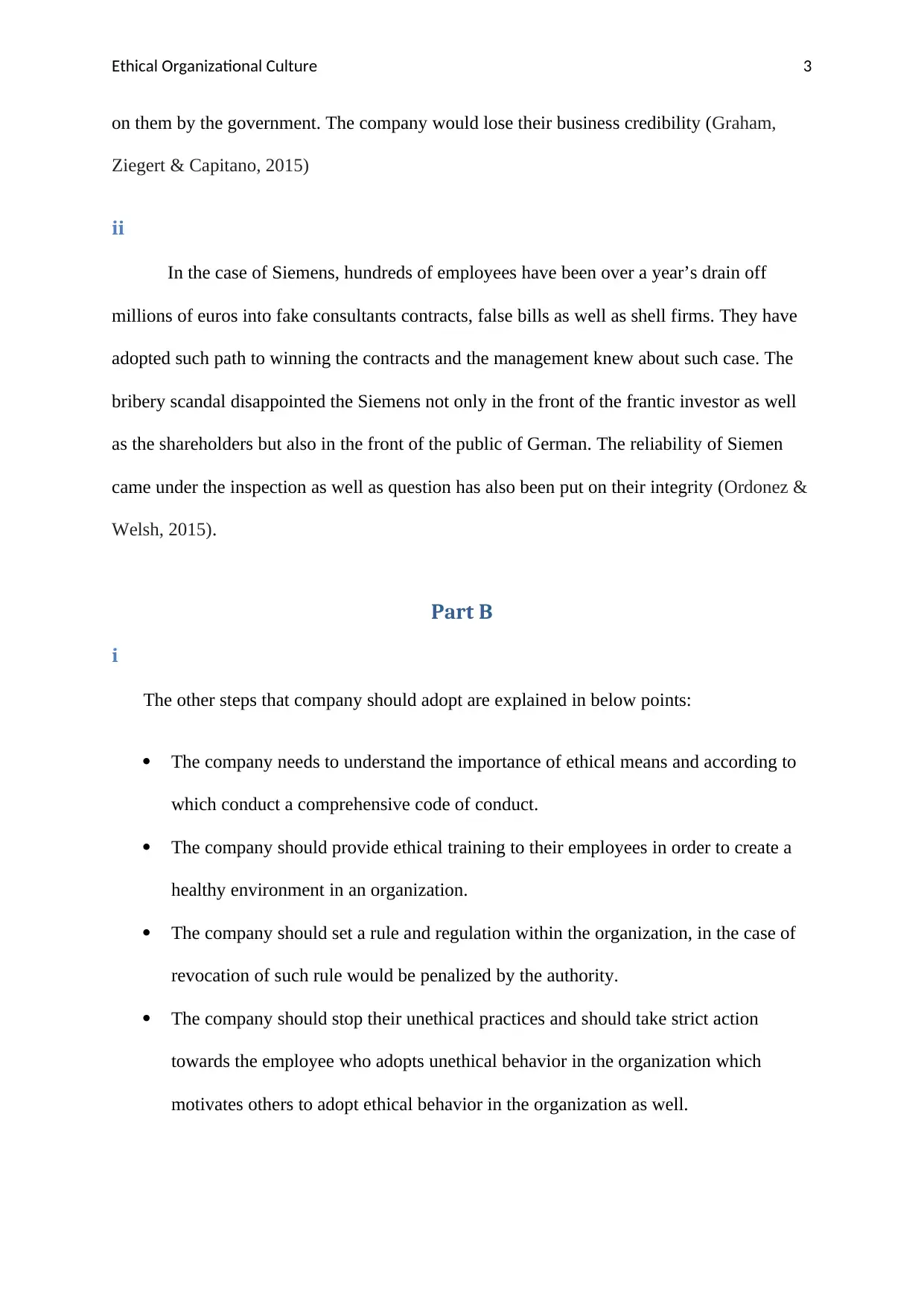
Ethical Organizational Culture 3
on them by the government. The company would lose their business credibility (Graham,
Ziegert & Capitano, 2015)
ii
In the case of Siemens, hundreds of employees have been over a year’s drain off
millions of euros into fake consultants contracts, false bills as well as shell firms. They have
adopted such path to winning the contracts and the management knew about such case. The
bribery scandal disappointed the Siemens not only in the front of the frantic investor as well
as the shareholders but also in the front of the public of German. The reliability of Siemen
came under the inspection as well as question has also been put on their integrity (Ordonez &
Welsh, 2015).
Part B
i
The other steps that company should adopt are explained in below points:
The company needs to understand the importance of ethical means and according to
which conduct a comprehensive code of conduct.
The company should provide ethical training to their employees in order to create a
healthy environment in an organization.
The company should set a rule and regulation within the organization, in the case of
revocation of such rule would be penalized by the authority.
The company should stop their unethical practices and should take strict action
towards the employee who adopts unethical behavior in the organization which
motivates others to adopt ethical behavior in the organization as well.
on them by the government. The company would lose their business credibility (Graham,
Ziegert & Capitano, 2015)
ii
In the case of Siemens, hundreds of employees have been over a year’s drain off
millions of euros into fake consultants contracts, false bills as well as shell firms. They have
adopted such path to winning the contracts and the management knew about such case. The
bribery scandal disappointed the Siemens not only in the front of the frantic investor as well
as the shareholders but also in the front of the public of German. The reliability of Siemen
came under the inspection as well as question has also been put on their integrity (Ordonez &
Welsh, 2015).
Part B
i
The other steps that company should adopt are explained in below points:
The company needs to understand the importance of ethical means and according to
which conduct a comprehensive code of conduct.
The company should provide ethical training to their employees in order to create a
healthy environment in an organization.
The company should set a rule and regulation within the organization, in the case of
revocation of such rule would be penalized by the authority.
The company should stop their unethical practices and should take strict action
towards the employee who adopts unethical behavior in the organization which
motivates others to adopt ethical behavior in the organization as well.
Paraphrase This Document
Need a fresh take? Get an instant paraphrase of this document with our AI Paraphraser
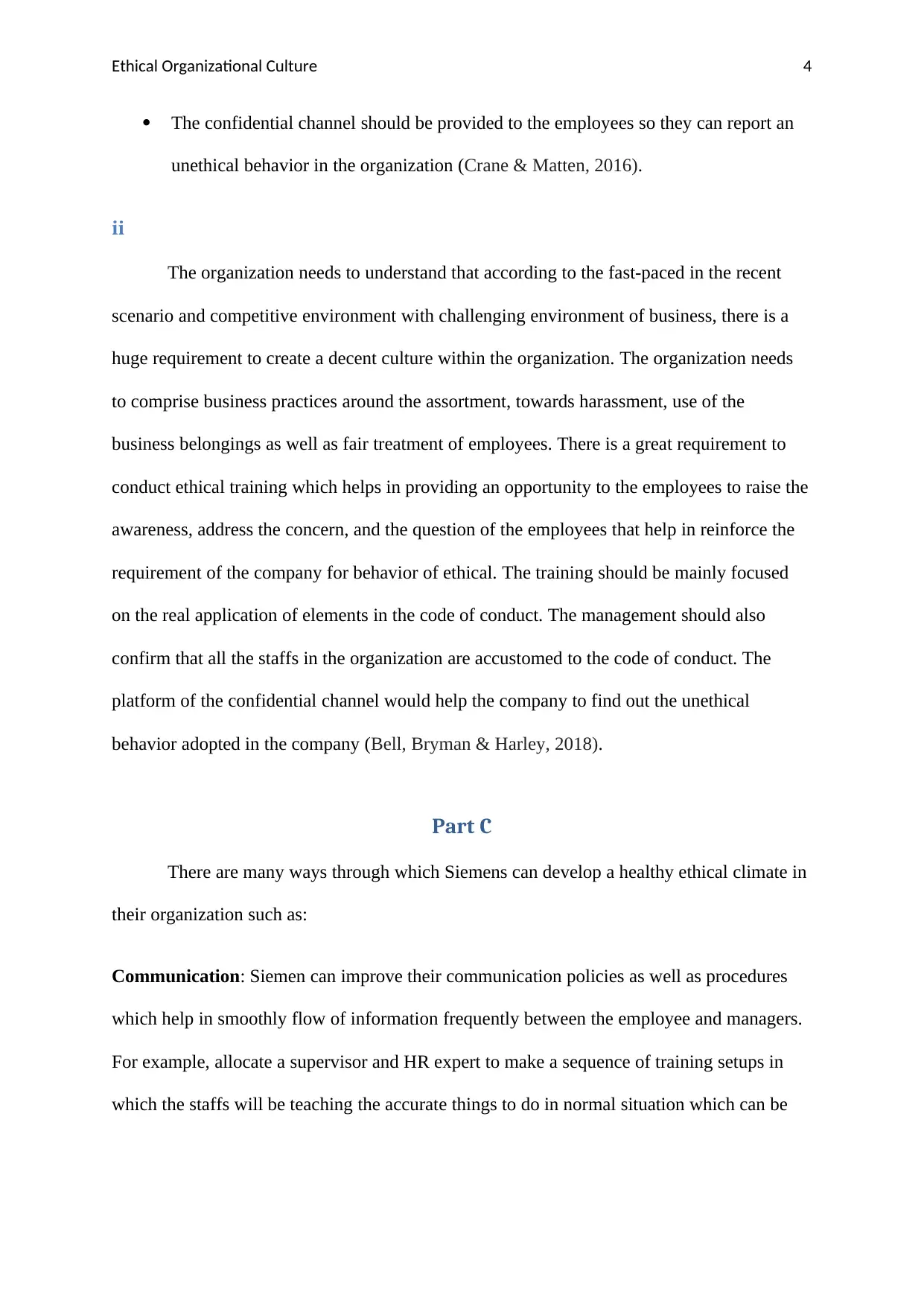
Ethical Organizational Culture 4
The confidential channel should be provided to the employees so they can report an
unethical behavior in the organization (Crane & Matten, 2016).
ii
The organization needs to understand that according to the fast-paced in the recent
scenario and competitive environment with challenging environment of business, there is a
huge requirement to create a decent culture within the organization. The organization needs
to comprise business practices around the assortment, towards harassment, use of the
business belongings as well as fair treatment of employees. There is a great requirement to
conduct ethical training which helps in providing an opportunity to the employees to raise the
awareness, address the concern, and the question of the employees that help in reinforce the
requirement of the company for behavior of ethical. The training should be mainly focused
on the real application of elements in the code of conduct. The management should also
confirm that all the staffs in the organization are accustomed to the code of conduct. The
platform of the confidential channel would help the company to find out the unethical
behavior adopted in the company (Bell, Bryman & Harley, 2018).
Part C
There are many ways through which Siemens can develop a healthy ethical climate in
their organization such as:
Communication: Siemen can improve their communication policies as well as procedures
which help in smoothly flow of information frequently between the employee and managers.
For example, allocate a supervisor and HR expert to make a sequence of training setups in
which the staffs will be teaching the accurate things to do in normal situation which can be
The confidential channel should be provided to the employees so they can report an
unethical behavior in the organization (Crane & Matten, 2016).
ii
The organization needs to understand that according to the fast-paced in the recent
scenario and competitive environment with challenging environment of business, there is a
huge requirement to create a decent culture within the organization. The organization needs
to comprise business practices around the assortment, towards harassment, use of the
business belongings as well as fair treatment of employees. There is a great requirement to
conduct ethical training which helps in providing an opportunity to the employees to raise the
awareness, address the concern, and the question of the employees that help in reinforce the
requirement of the company for behavior of ethical. The training should be mainly focused
on the real application of elements in the code of conduct. The management should also
confirm that all the staffs in the organization are accustomed to the code of conduct. The
platform of the confidential channel would help the company to find out the unethical
behavior adopted in the company (Bell, Bryman & Harley, 2018).
Part C
There are many ways through which Siemens can develop a healthy ethical climate in
their organization such as:
Communication: Siemen can improve their communication policies as well as procedures
which help in smoothly flow of information frequently between the employee and managers.
For example, allocate a supervisor and HR expert to make a sequence of training setups in
which the staffs will be teaching the accurate things to do in normal situation which can be
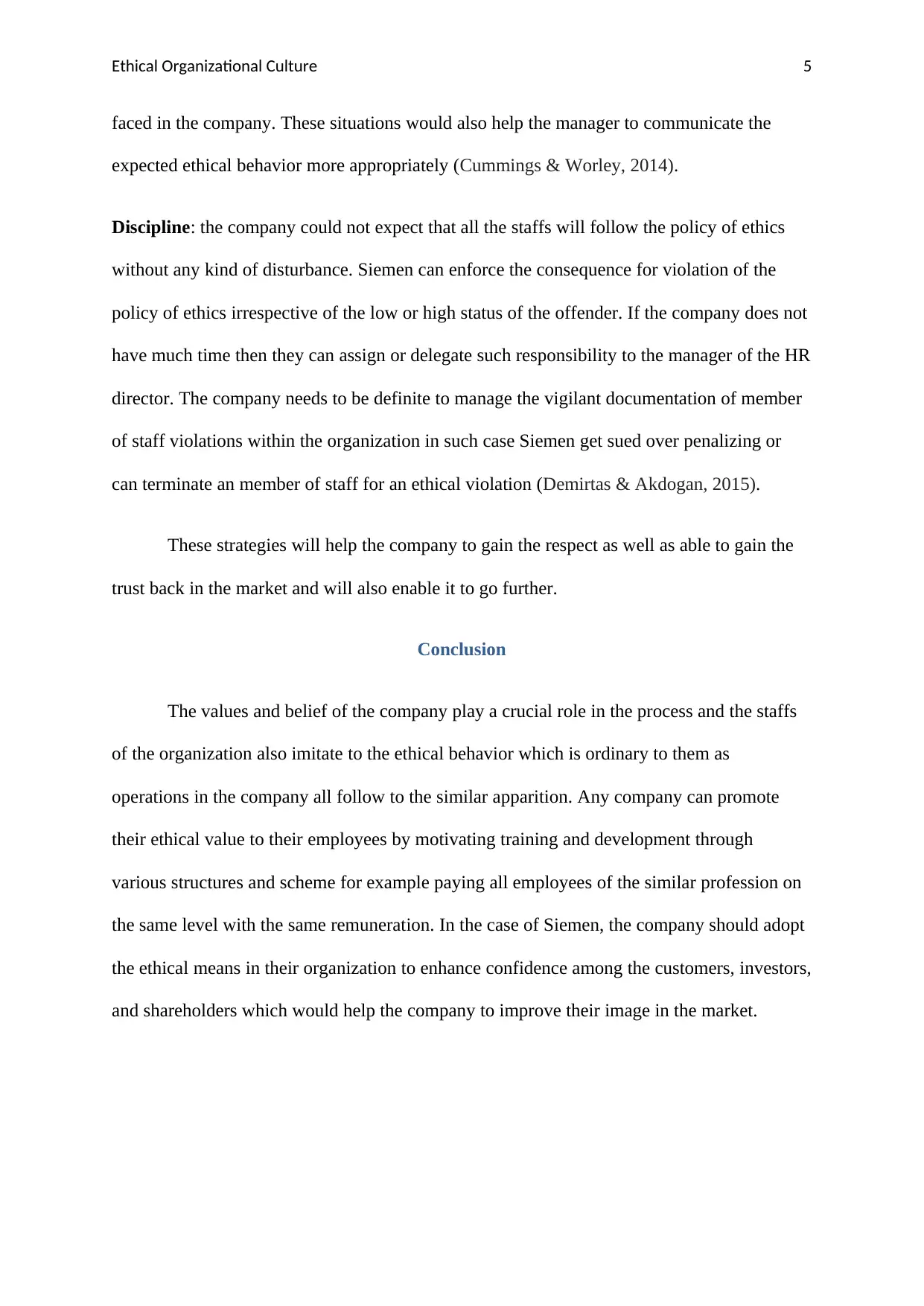
Ethical Organizational Culture 5
faced in the company. These situations would also help the manager to communicate the
expected ethical behavior more appropriately (Cummings & Worley, 2014).
Discipline: the company could not expect that all the staffs will follow the policy of ethics
without any kind of disturbance. Siemen can enforce the consequence for violation of the
policy of ethics irrespective of the low or high status of the offender. If the company does not
have much time then they can assign or delegate such responsibility to the manager of the HR
director. The company needs to be definite to manage the vigilant documentation of member
of staff violations within the organization in such case Siemen get sued over penalizing or
can terminate an member of staff for an ethical violation (Demirtas & Akdogan, 2015).
These strategies will help the company to gain the respect as well as able to gain the
trust back in the market and will also enable it to go further.
Conclusion
The values and belief of the company play a crucial role in the process and the staffs
of the organization also imitate to the ethical behavior which is ordinary to them as
operations in the company all follow to the similar apparition. Any company can promote
their ethical value to their employees by motivating training and development through
various structures and scheme for example paying all employees of the similar profession on
the same level with the same remuneration. In the case of Siemen, the company should adopt
the ethical means in their organization to enhance confidence among the customers, investors,
and shareholders which would help the company to improve their image in the market.
faced in the company. These situations would also help the manager to communicate the
expected ethical behavior more appropriately (Cummings & Worley, 2014).
Discipline: the company could not expect that all the staffs will follow the policy of ethics
without any kind of disturbance. Siemen can enforce the consequence for violation of the
policy of ethics irrespective of the low or high status of the offender. If the company does not
have much time then they can assign or delegate such responsibility to the manager of the HR
director. The company needs to be definite to manage the vigilant documentation of member
of staff violations within the organization in such case Siemen get sued over penalizing or
can terminate an member of staff for an ethical violation (Demirtas & Akdogan, 2015).
These strategies will help the company to gain the respect as well as able to gain the
trust back in the market and will also enable it to go further.
Conclusion
The values and belief of the company play a crucial role in the process and the staffs
of the organization also imitate to the ethical behavior which is ordinary to them as
operations in the company all follow to the similar apparition. Any company can promote
their ethical value to their employees by motivating training and development through
various structures and scheme for example paying all employees of the similar profession on
the same level with the same remuneration. In the case of Siemen, the company should adopt
the ethical means in their organization to enhance confidence among the customers, investors,
and shareholders which would help the company to improve their image in the market.
⊘ This is a preview!⊘
Do you want full access?
Subscribe today to unlock all pages.

Trusted by 1+ million students worldwide
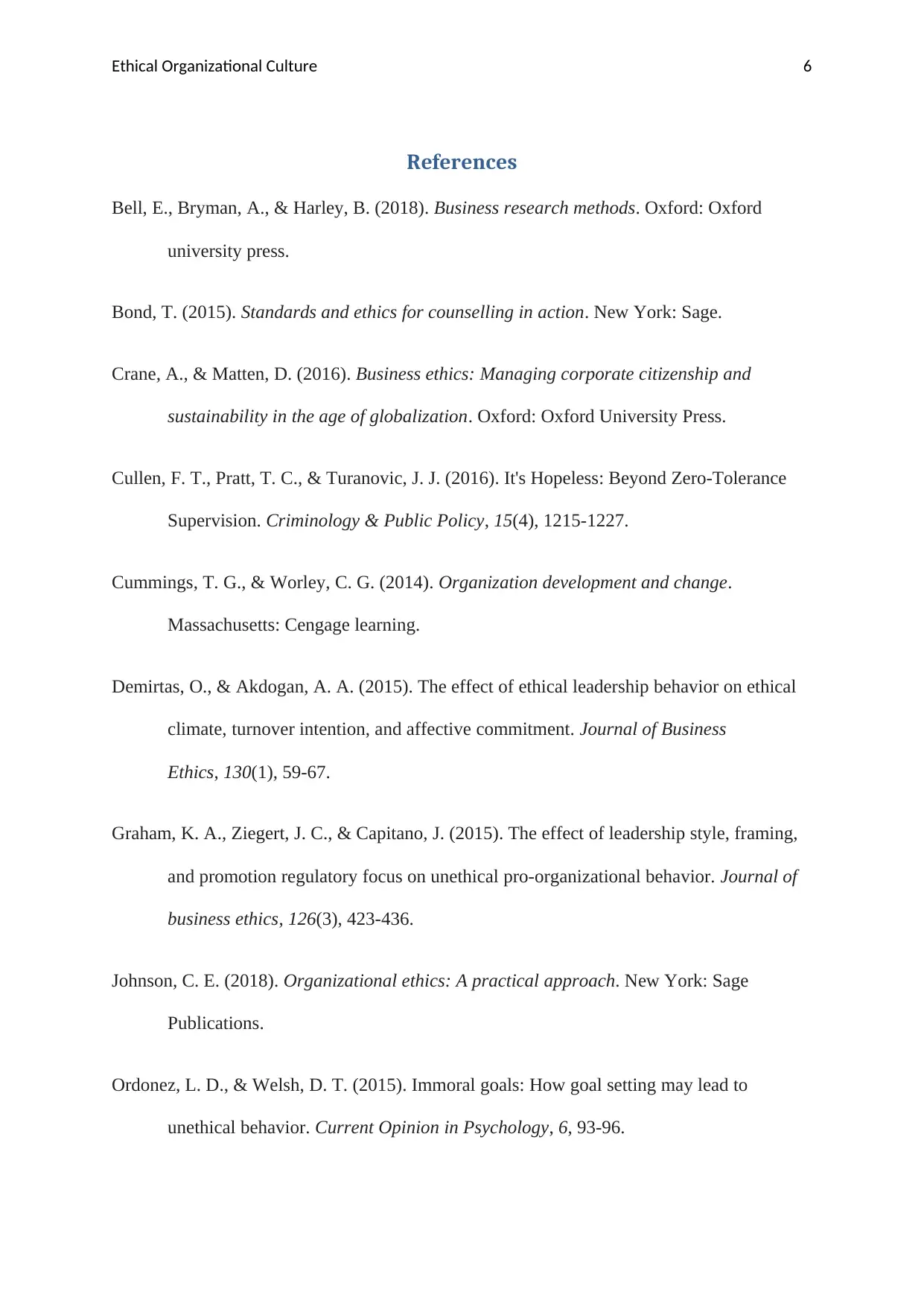
Ethical Organizational Culture 6
References
Bell, E., Bryman, A., & Harley, B. (2018). Business research methods. Oxford: Oxford
university press.
Bond, T. (2015). Standards and ethics for counselling in action. New York: Sage.
Crane, A., & Matten, D. (2016). Business ethics: Managing corporate citizenship and
sustainability in the age of globalization. Oxford: Oxford University Press.
Cullen, F. T., Pratt, T. C., & Turanovic, J. J. (2016). It's Hopeless: Beyond Zero‐Tolerance
Supervision. Criminology & Public Policy, 15(4), 1215-1227.
Cummings, T. G., & Worley, C. G. (2014). Organization development and change.
Massachusetts: Cengage learning.
Demirtas, O., & Akdogan, A. A. (2015). The effect of ethical leadership behavior on ethical
climate, turnover intention, and affective commitment. Journal of Business
Ethics, 130(1), 59-67.
Graham, K. A., Ziegert, J. C., & Capitano, J. (2015). The effect of leadership style, framing,
and promotion regulatory focus on unethical pro-organizational behavior. Journal of
business ethics, 126(3), 423-436.
Johnson, C. E. (2018). Organizational ethics: A practical approach. New York: Sage
Publications.
Ordonez, L. D., & Welsh, D. T. (2015). Immoral goals: How goal setting may lead to
unethical behavior. Current Opinion in Psychology, 6, 93-96.
References
Bell, E., Bryman, A., & Harley, B. (2018). Business research methods. Oxford: Oxford
university press.
Bond, T. (2015). Standards and ethics for counselling in action. New York: Sage.
Crane, A., & Matten, D. (2016). Business ethics: Managing corporate citizenship and
sustainability in the age of globalization. Oxford: Oxford University Press.
Cullen, F. T., Pratt, T. C., & Turanovic, J. J. (2016). It's Hopeless: Beyond Zero‐Tolerance
Supervision. Criminology & Public Policy, 15(4), 1215-1227.
Cummings, T. G., & Worley, C. G. (2014). Organization development and change.
Massachusetts: Cengage learning.
Demirtas, O., & Akdogan, A. A. (2015). The effect of ethical leadership behavior on ethical
climate, turnover intention, and affective commitment. Journal of Business
Ethics, 130(1), 59-67.
Graham, K. A., Ziegert, J. C., & Capitano, J. (2015). The effect of leadership style, framing,
and promotion regulatory focus on unethical pro-organizational behavior. Journal of
business ethics, 126(3), 423-436.
Johnson, C. E. (2018). Organizational ethics: A practical approach. New York: Sage
Publications.
Ordonez, L. D., & Welsh, D. T. (2015). Immoral goals: How goal setting may lead to
unethical behavior. Current Opinion in Psychology, 6, 93-96.
Paraphrase This Document
Need a fresh take? Get an instant paraphrase of this document with our AI Paraphraser
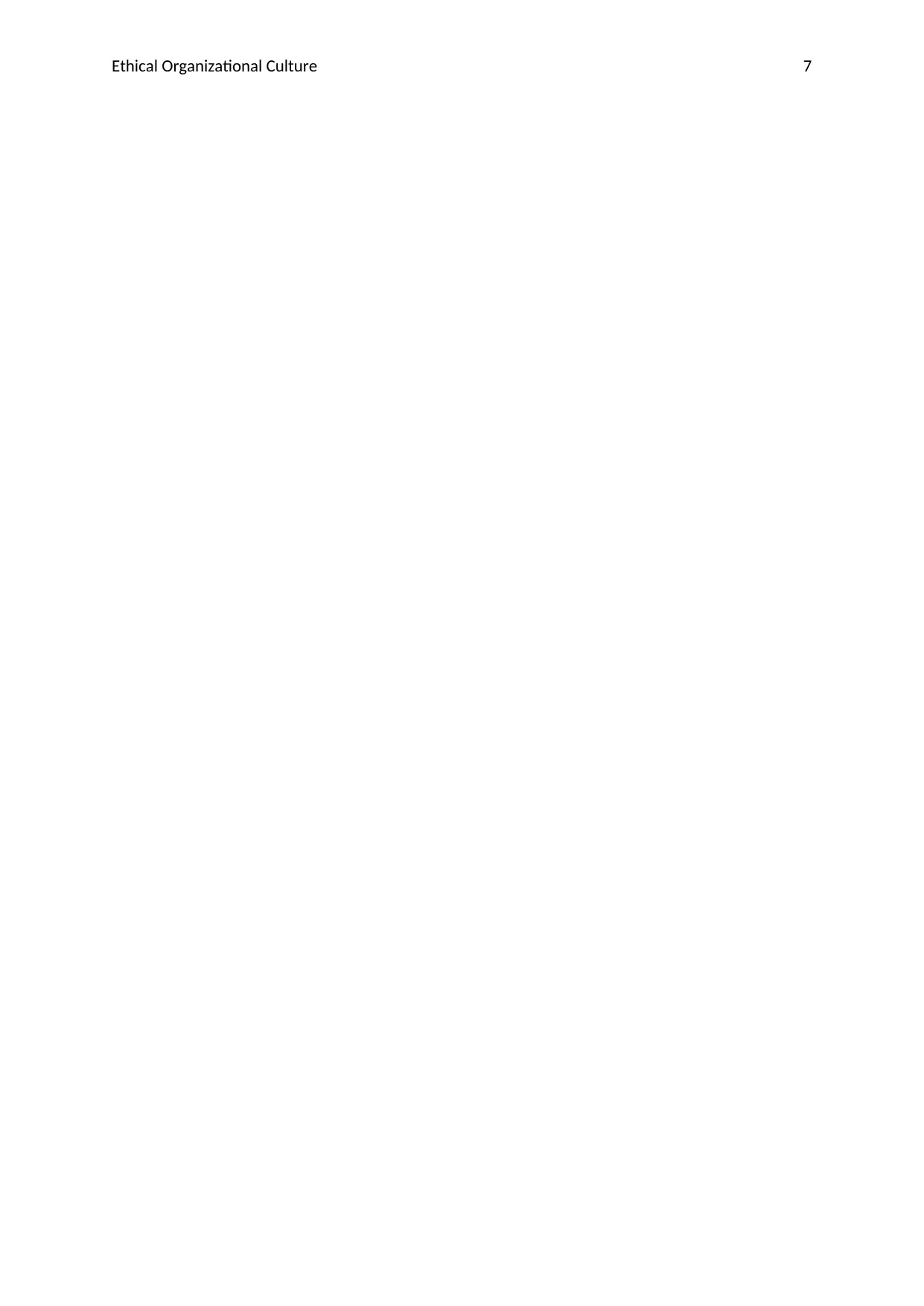
Ethical Organizational Culture 7
1 out of 8
Related Documents
Your All-in-One AI-Powered Toolkit for Academic Success.
+13062052269
info@desklib.com
Available 24*7 on WhatsApp / Email
![[object Object]](/_next/static/media/star-bottom.7253800d.svg)
Unlock your academic potential
Copyright © 2020–2025 A2Z Services. All Rights Reserved. Developed and managed by ZUCOL.





